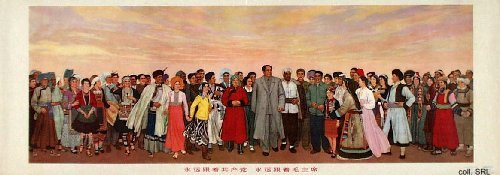 Two days after the arrest of the Gang, the highest organs of the party and the state decided that a Memorial Hall would be built as a permanent tribute to the founder of the People's Republic. On 24 November 1976, the foundation stone for the gigantic building, located to the south of the Monument to the People's Heroes on Tian'anmen Square, was put in place. Both Hua and Ye, the strong men of the immediate post-Mao era, were prominently present at the ceremony.
Two days after the arrest of the Gang, the highest organs of the party and the state decided that a Memorial Hall would be built as a permanent tribute to the founder of the People's Republic. On 24 November 1976, the foundation stone for the gigantic building, located to the south of the Monument to the People's Heroes on Tian'anmen Square, was put in place. Both Hua and Ye, the strong men of the immediate post-Mao era, were prominently present at the ceremony. The construction went on day and night, and the building was finished on 29 August 1977. On that same day, Mao's body, which had been embalmed and placed in a crystal sarcophagus, was moved to the Hall. On 9 September 1977, a ceremony was held to commemorate the anniversary of Mao's death and the completion of the Hall.
The construction went on day and night, and the building was finished on 29 August 1977. On that same day, Mao's body, which had been embalmed and placed in a crystal sarcophagus, was moved to the Hall. On 9 September 1977, a ceremony was held to commemorate the anniversary of Mao's death and the completion of the Hall.
 In December 1983, four memorial rooms were added to the Memorial Hall, which serve as reception rooms for important guests. Aside from the one to the left of the entrance hall, which is dedicated to Mao, the others are dedicated to his former colleagues of the First Generation of leaders, Zhou Enlai, Liu Shaoqi and Zhu De. For many artists and designers, contributing works to the Hall is seen as a mark of distinction, proof of them being in tune with the national mood. One of these contributing artists is Liu Yuyi, known for his huge canvasses that commemorate landmarks in recent Chinese (and world) history.
In December 1983, four memorial rooms were added to the Memorial Hall, which serve as reception rooms for important guests. Aside from the one to the left of the entrance hall, which is dedicated to Mao, the others are dedicated to his former colleagues of the First Generation of leaders, Zhou Enlai, Liu Shaoqi and Zhu De. For many artists and designers, contributing works to the Hall is seen as a mark of distinction, proof of them being in tune with the national mood. One of these contributing artists is Liu Yuyi, known for his huge canvasses that commemorate landmarks in recent Chinese (and world) history.
 Although the Hall is open to the general public, it tends to be closed for maintenance purposes for extended periods of time. For precisely these reasons, the Hall was closed in the Summer of 2007 in preparation for the Olympic Games of 2008. It is unclear whether this maintenance is needed for the upkeep of the building, or for Mao's remains. Nonetheless, the Hall still draws large crowds of visitors, many of whom lay flowers at the foot of a marble statue of a sitting Mao, located in the northern entrance hall.
Although the Hall is open to the general public, it tends to be closed for maintenance purposes for extended periods of time. For precisely these reasons, the Hall was closed in the Summer of 2007 in preparation for the Olympic Games of 2008. It is unclear whether this maintenance is needed for the upkeep of the building, or for Mao's remains. Nonetheless, the Hall still draws large crowds of visitors, many of whom lay flowers at the foot of a marble statue of a sitting Mao, located in the northern entrance hall.

No comments:
Post a Comment